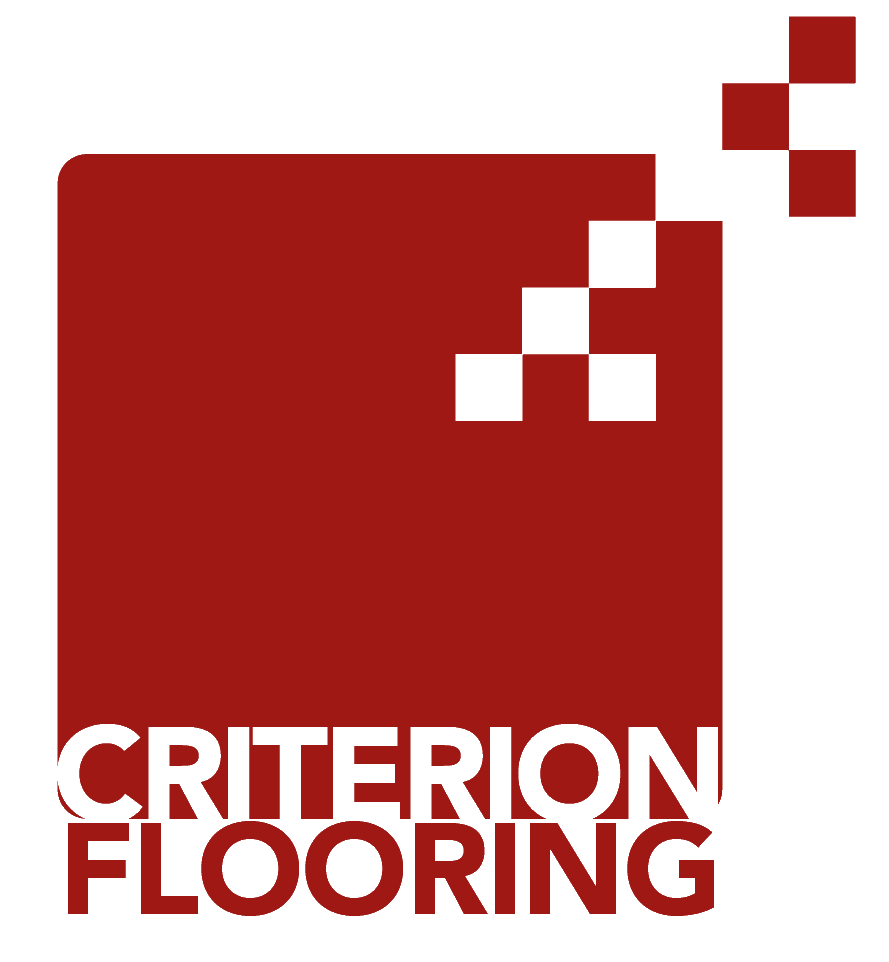Frequently asked Questions about your wood flooring...
Cleaning and maintaining a lacquered wood floor
Regular cleaning and maintenance is advisable to keep your floor looking great.
Clean to remove dirt and dust particles, and damp cleaning to keep the floor looking brand new and protect it against unsightly scratches. Occasionally you will want to re apply varnish to provide continued protection.
Maintaining an oiled wood floor
Most important is to not to use steam cleaners or scrubber dryers.
Dry clean the floor with a vacuum or a soft brush to remove grit or dirt and use a damp cloth to clean the floor weekly using a lightly applied cleaning product. For a more significant clean you can thinly apply a concentrated cleaner or completely re-apply a hard-wax oil Call Criterion Flooring for further advice.
The simple answer is yes. An engineered wood floor from Criterion flooring is constructed to be stable and have a low enough moisture content for under floor heating.
Solid flooring however is not suitable for underfloor heating. ,
NB. Wood floors over under floor heating should not exceed a surface temperature of 27 degrees Celsius.
Do I need underlay for my floor?
A thin material laid between the subfloor and the floor (Underlay) is used to enhance. stability, insulation, sound reduction, and moisture protection.
Are you installing Underfloor Heating?
We suggest Heatflow Wood Underlay if you’re installing Underfloor Heating because of its low tog value.
The fitting of an Underlay beneath your floor both incorporates a moisture barrier, adds stability and reduces noise.
There are different grades of wood depending on their quality and natural patterns and traits. ie different thicknesses, wood all from the same tree or the grain pattern may help determine the grade.
Here are examples of differing grades of Oaks available:
Oak Flooring Grades
Premier Grade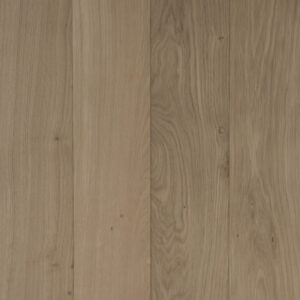
Premier grade is also known as Prime, Select, or A B grade. It is the highest grade of flooring that we provide. It is considered cleaner, more contemporary looking with minimal knots. Premier grade Oak is usually more expensive than other flooring grades.
Natural Grade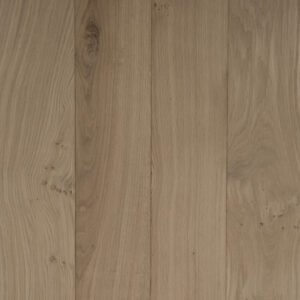
Natural grade flooring has larger more frequent knots than Premier. It allows for some colour variation, mineral streaking, and a more variable grain pattern. It looks less uniform and is more characterful as a result.
Mill-run Grade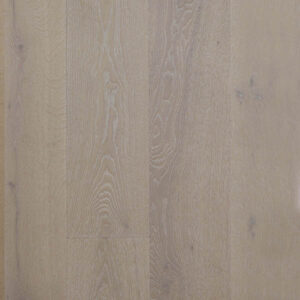
Mill-run is a mixed grade with qualities from both Natural and Premier grades. It is used for factory-finished products in general.
Looking for a particular grade?
The above-detailed grades of flooring all share the same structural quality and are all made to last.
*The above pics are for example only.
Our mouldings are available in Oak, Merbau or Walnut.
The type of Moulding Trim used will depend on the features it is used with:
L’ Sections are used where a wooden floor meets a structure such as a fireplace hearth, or against patio doors.
Stair nose moulding is used to provide a neat finish on the edge of a wooden floor, transitioning down to a staircase or step.
A ‘T’ bar provides an attractive finish between two different surfaces that are on the same level, a ‘Threshold’ moulding can bring together two surfaces on levels different together.
A a solid board is a single piece of solid timber, whereas an engineered floor is made up of several layers.
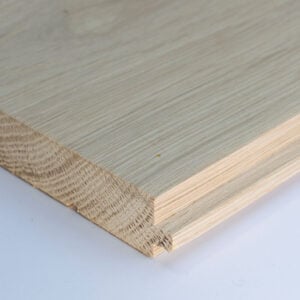
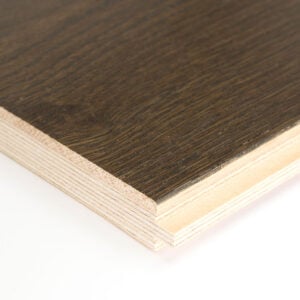
Why are engineered boards made up of layers?
An engineered board has layers of plywood backing, with each layer glued to the adjoining layer. The surface layer of hardwood is then glued on top.
This helps create a more stable floor with a robust construction, resistant to changes in it’s environment.
Engineered boards however, can be fitted in most rooms in the house. They can also be floated or fixed to most types of subfloor together with an underlay. So an acoustic underlay can be used to reduce sound if the floor is fitted in for example; apartments or upper floors.
There is a trend towards engineered flooring because of the yechnological advances which has enabled wood flooring to be installed in environments that were previously unsuitable for wood. There is also these days a greater variety in engineered flooring products available.
‘Overlay’refers to the thickness of the floor.
Any floor that is less than 18mm thick is a non-structural product, and falls under the ‘overlay’ category. A structural product is one that can be laid directly over beams, not requiring a subfloor. (An Overlay is never laid on a floor like this)
Overlay products are laid over an existing subfloor ie floor boards already in place, concrete, plywood, or chip board.
Ask us for details on our range of Engineered overlay floors. They are mostly 15mm thick and pre-finished with a lacquer or an oil.
A baked oak floor is a rich dark brown colour with a more uniform appearance. Because this wood is sourced from unsustainable origins or produced in an environmentally dubious way, a baked oak floor is a sustainable alternative to exotic species that provides the same rich appeal of a dark wood floor.
The process is chemical free.( fumed or smoked floors are treated with ammonia!)
- There is no need to stain the top layer for colouring the floor.
- The colour of the wood survives normal wear and tear.
- ( stained floors need re-staining after long term use).
The bevel provides enhanced aesthetics and also it levels the two surfaces where they meet to give a neater look and prevent exposed edges which might need additional sanding. The bevelled edge compensates for any slight differences in the floor level..
A floating floor is a floor of engineered boards (excluding parquet woodblocks) that is fitted on top of an underlay and not fixed to an existing substrate.
A Floating floor is fitted to…
- Accommodate underfloor heating
- Provide sound reduction material
- To provide a moisture resistant barrier
- Add insulating material
Engineered floors (except for parquet woodblocks) are suitable for floating.
Or you can float an engineered floor on an underlay. (not all floors can be floated!)
Another option is to create a wooden subfloor, with plywood or with battens bonded to the concrete or screed. If you want to glue the flooring directly to the concrete, you will need to investigate the best adhesives or give Luke a call at Criterion Flooring.
Wood must be acclimatised to the environment it is to be laid in. Wood is a natural product, so it takes on moisture when the air has high humidity and loses moisture when the air is dry.
Wood expands when taking on moisture and contracts when it loses moisture. To minimise the effects of this expansion and contraction, it is advisable to acclimatise all wood floors for two weeks prior to fitting. This is critical with solid flooring compared to engineered boards, as Engineered boards are dried to a lower moisture content and have a more stable construction.
NB. The type of flooring and the season in which you will be laying the floor will affect the duration of acclimatisation.
Solid wood flooring should be left to acclimatise at room temperature for a minimum of 10 days prior to fitting.
NB. It should be stacked with spaces every 6-8 boards to help air flow.
For engineered flooring is kept in its original packaging throughout the process to acclimatise it to a lower moisture content to allow it to be used inconjunction with under floor heating. The wood must be laid flat and not stood on its ends.
NB. Plastering and other wet work should be completed and thoroughly dry prior to bringing the wood into the environment.
It is always advisable to order a little more than you need to cover wastage from cutting or to use individual boards in certain positions.
Measure the room in which the floor is to be fitted.
NB. Allow 7-10% extra area for board or strip floors, and 15% extra for parquet woodblocks.
Almost every wood floor will endure some expansion and contraction as seasons and humidity levels change. When homes are heated, humidity levels fall, so boards shrink and spaces to appear between the boards. In very dry months, cracks can appear
With lighter coloured woods, the gaps may appear larger because of the contrast between the gap and the colour of the wood. Square edge boards also show cracks more. It is natural for these spaces to appear and will usually close up as the season changes and moisture returns to the air.
To reduce the degree of change, you can add moisture to the air during the dry months by installing humidifier or placing some potted plants in the room!
Wood if in direct sunlight may fade in colour over time. It is a natural product afterall! Depending on the type of wood and how extensively it is subject to direct sunlight will make a difference to how significantly it is affected.
But don’t forget you can always refinish it stain it to restore the desired colour.
To protect your floor it is recommended to varnish it regularly, re-sand it occasionally (every couple of years) to restore it to it’s original condition.
